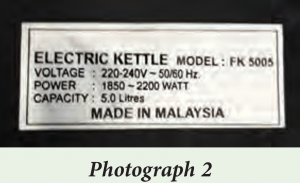Question 7:
Photograph 2 shows the power rating label of an electric kettle.

(a) What is the maximum power of this electric kettle?
(b) Calculate the time taken by this kettle to change 0.5 kg of boiling water at 100°C into steam at 100°C when the kettle operates at maximum power.
[Specific latent heat of vaporisation of water = 2.26 × 106 J kg–1]
(c) What assumptions are made in your calculations in 7(b)?
Answer:
(a) Maximum power of this electric kettle = 2 200 W
(b)
\begin{aligned} & Q=m l \\ & P t=m l \\ & 2200 \times t=0.5 \times 2.26 \times 10^6 \\ & l=\frac{0.5 \times 2.26 \times 10^6}{2200} \\ & t=513.6 \mathrm{~s}\end{aligned}
(c)
Photograph 2 shows the power rating label of an electric kettle.

(a) What is the maximum power of this electric kettle?
(b) Calculate the time taken by this kettle to change 0.5 kg of boiling water at 100°C into steam at 100°C when the kettle operates at maximum power.
[Specific latent heat of vaporisation of water = 2.26 × 106 J kg–1]
(c) What assumptions are made in your calculations in 7(b)?
Answer:
(a) Maximum power of this electric kettle = 2 200 W
(b)
\begin{aligned} & Q=m l \\ & P t=m l \\ & 2200 \times t=0.5 \times 2.26 \times 10^6 \\ & l=\frac{0.5 \times 2.26 \times 10^6}{2200} \\ & t=513.6 \mathrm{~s}\end{aligned}
(c)
– All heat supplied by the heating element of the kettle is absorbed by the boiling water.
– No heat is lost to the surroundings.
Question 8:
Air in the tyre of a car has a pressure of 220 kPa at initial temperature of 27°C. After a race, the temperature of the air increases to 87°C.
(a) Calculate the air pressure in the tyre after the race.
(b) What assumptions did you make in 8(a)?
Answer:
(a)
Gay-Lussac’s Law formula: $$ \begin{gathered} \frac{P_1}{T_1}=\frac{P_2}{T_2} \\ \frac{220}{\left(27^{\circ} \mathrm{C}+273\right)}=\frac{P_2}{\left(87^{\circ} \mathrm{C}+273\right)} \end{gathered} $$
\begin{aligned} \frac{220}{300 K} & =\frac{P_2}{360 K} \\ P_2 & =\frac{220 \times 360}{300} \\ P_2 & =264 \mathrm{kPa} \end{aligned}
(b) Volume of tyre remains unchanged.
Air in the tyre of a car has a pressure of 220 kPa at initial temperature of 27°C. After a race, the temperature of the air increases to 87°C.
(a) Calculate the air pressure in the tyre after the race.
(b) What assumptions did you make in 8(a)?
Answer:
(a)
Gay-Lussac’s Law formula: $$ \begin{gathered} \frac{P_1}{T_1}=\frac{P_2}{T_2} \\ \frac{220}{\left(27^{\circ} \mathrm{C}+273\right)}=\frac{P_2}{\left(87^{\circ} \mathrm{C}+273\right)} \end{gathered} $$
\begin{aligned} \frac{220}{300 K} & =\frac{P_2}{360 K} \\ P_2 & =\frac{220 \times 360}{300} \\ P_2 & =264 \mathrm{kPa} \end{aligned}
(b) Volume of tyre remains unchanged.
